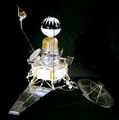Template:Selected anniversaries/January 26: Difference between revisions
No edit summary |
No edit summary |
||
| Line 14: | Line 14: | ||
File:Arthur Cayley.jpg|link=Arthur Cayley (nonfiction)|1895: Mathematician and academic [[Arthur Cayley (nonfiction)|Arthur Cayley]] dies. He was the first to define the concept of a group in the modern way, as a set with a binary operation satisfying certain laws. | File:Arthur Cayley.jpg|link=Arthur Cayley (nonfiction)|1895: Mathematician and academic [[Arthur Cayley (nonfiction)|Arthur Cayley]] dies. He was the first to define the concept of a group in the modern way, as a set with a binary operation satisfying certain laws. | ||
||Polykarp Kusch (b. January 26, 1911) was a German-American physicist. In 1955, the Nobel Committee gave a divided Nobel Prize for Physics, with one half to going to Kusch for his accurate determination that the magnetic moment of the electron was greater than its theoretical value, thus leading to reconsideration of—and innovations in—quantum electrodynamics. | |||
File:John Logie Baird 1917.jpg|link=John Logie Baird (nonfiction)|1926: The first demonstration of the television by [[John Logie Baird (nonfiction)|John Logie Baird]]. | File:John Logie Baird 1917.jpg|link=John Logie Baird (nonfiction)|1926: The first demonstration of the television by [[John Logie Baird (nonfiction)|John Logie Baird]]. | ||
||Constantin Marie Le Paige ( | ||Constantin Marie Le Paige (d. 26 January 1929) was a Belgian mathematician. He worked on the theory of algebraic form, especially algebraic curves and surface and more particularly for his work on the construction of cubic surfaces. | ||
|| | ||Donald Erik Sarason (b. January 26, 1933) was an American mathematician who made fundamental advances in the areas of Hardy space theory and VMO. Pic. | ||
File:Six Seconds to Hell.jpg|link=Six Seconds to Hell|1936: Steganographic analysis of ''[[Six Seconds to Hell]]'' reveals advance knowledge of the upcoming [[Hindenburg disaster (nonfiction)|Hindenburg disaster]]. | File:Six Seconds to Hell.jpg|link=Six Seconds to Hell|1936: Steganographic analysis of ''[[Six Seconds to Hell]]'' reveals advance knowledge of the upcoming [[Hindenburg disaster (nonfiction)|Hindenburg disaster]]. | ||
| Line 26: | Line 28: | ||
|File:ENIAC Empty-Noise-Into Alien-Communication.jpg|1946: ENIAC ("[[Empty Noise Into Alien Communication]]") successfully refactors the [[Wow! signal (nonfiction)|Wow! signal]]. | |File:ENIAC Empty-Noise-Into Alien-Communication.jpg|1946: ENIAC ("[[Empty Noise Into Alien Communication]]") successfully refactors the [[Wow! signal (nonfiction)|Wow! signal]]. | ||
File:Richard Courant.jpg|link=Richard Courant (nonfiction)|1961: Mathematician and crime-fighter [[Richard Courant (nonfiction)|Richard Courant]] publishes new class of [[Gnomon algorithm functions]] which detect and prevent [[crimes against mathematical constants]]. | File:Richard Courant.jpg|link=Richard Courant (nonfiction)|1961: Mathematician and crime-fighter [[Richard Courant (nonfiction)|Richard Courant]] publishes new class of [[Gnomon algorithm functions]] which detect and prevent [[crimes against mathematical constants]]. | ||
Revision as of 18:43, 12 February 2018
1848: Mathematician and crime-fighter János Bolyai publishes new theory of non-Euclidean geometry which detects and prevents crimes against mathematical constants.
1857: Printer, bookseller, and inventor Édouard-Léon Scott de Martinville submits sealed patent application for the phonoautograph, which records an audio signal as a photographic image.
1884: Signed first edition of Alice Beta and Niles Cartouchian Play Chess sells for two hundred thousand dollars in charity benefit for victims of crimes against mathematical constants.
1885: Physician, scientist, and inventor Edward Davy dies. He played a prominent role in the development of telegraphy, and invented an electric relay.
1895: Mathematician and academic Arthur Cayley dies. He was the first to define the concept of a group in the modern way, as a set with a binary operation satisfying certain laws.
1926: The first demonstration of the television by John Logie Baird.
1936: Steganographic analysis of Six Seconds to Hell reveals advance knowledge of the upcoming Hindenburg disaster.
1943: American eugenicist and sociologist Harry H. Laughlin dies. He will be the Superintendent of the Eugenics Record Office from its inception in 1910 to its closing in 1939, and among the most active individuals in influencing American eugenics policy, especially compulsory sterilization legislation.
1961: Mathematician and crime-fighter Richard Courant publishes new class of Gnomon algorithm functions which detect and prevent crimes against mathematical constants.
1962: Ranger 3 is launched to study the Moon. The space probe later misses the moon by 22,000 miles (35,400 km).
1963: The Flying Diner announces twice-daily flights between New Minneapolis, Canada and Saint Paul, Minnesota.










